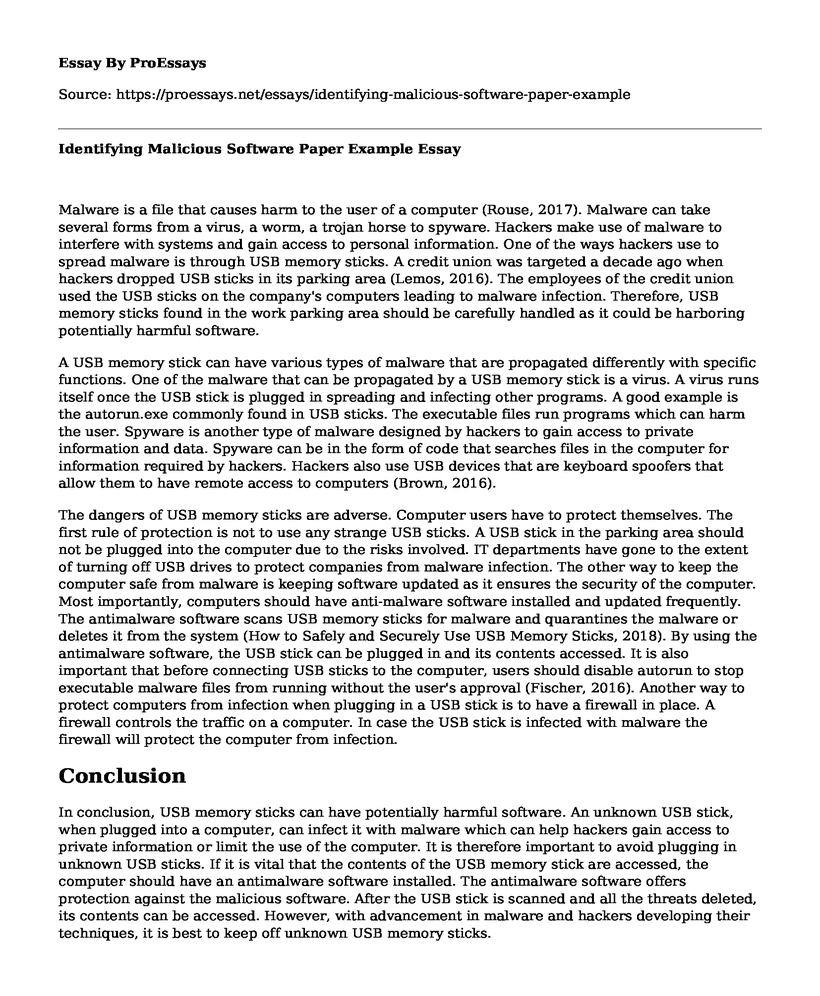Malware is a file that causes harm to the user of a computer (Rouse, 2017). Malware can take several forms from a virus, a worm, a trojan horse to spyware. Hackers make use of malware to interfere with systems and gain access to personal information. One of the ways hackers use to spread malware is through USB memory sticks. A credit union was targeted a decade ago when hackers dropped USB sticks in its parking area (Lemos, 2016). The employees of the credit union used the USB sticks on the company's computers leading to malware infection. Therefore, USB memory sticks found in the work parking area should be carefully handled as it could be harboring potentially harmful software.
A USB memory stick can have various types of malware that are propagated differently with specific functions. One of the malware that can be propagated by a USB memory stick is a virus. A virus runs itself once the USB stick is plugged in spreading and infecting other programs. A good example is the autorun.exe commonly found in USB sticks. The executable files run programs which can harm the user. Spyware is another type of malware designed by hackers to gain access to private information and data. Spyware can be in the form of code that searches files in the computer for information required by hackers. Hackers also use USB devices that are keyboard spoofers that allow them to have remote access to computers (Brown, 2016).
The dangers of USB memory sticks are adverse. Computer users have to protect themselves. The first rule of protection is not to use any strange USB sticks. A USB stick in the parking area should not be plugged into the computer due to the risks involved. IT departments have gone to the extent of turning off USB drives to protect companies from malware infection. The other way to keep the computer safe from malware is keeping software updated as it ensures the security of the computer. Most importantly, computers should have anti-malware software installed and updated frequently. The antimalware software scans USB memory sticks for malware and quarantines the malware or deletes it from the system (How to Safely and Securely Use USB Memory Sticks, 2018). By using the antimalware software, the USB stick can be plugged in and its contents accessed. It is also important that before connecting USB sticks to the computer, users should disable autorun to stop executable malware files from running without the user's approval (Fischer, 2016). Another way to protect computers from infection when plugging in a USB stick is to have a firewall in place. A firewall controls the traffic on a computer. In case the USB stick is infected with malware the firewall will protect the computer from infection.
Conclusion
In conclusion, USB memory sticks can have potentially harmful software. An unknown USB stick, when plugged into a computer, can infect it with malware which can help hackers gain access to private information or limit the use of the computer. It is therefore important to avoid plugging in unknown USB sticks. If it is vital that the contents of the USB memory stick are accessed, the computer should have an antimalware software installed. The antimalware software offers protection against the malicious software. After the USB stick is scanned and all the threats deleted, its contents can be accessed. However, with advancement in malware and hackers developing their techniques, it is best to keep off unknown USB memory sticks.
References
Brown, B. (2016, August 5). Malware alert - don't plug in that USB stick you found on the street. Retrieved from https://www.digitaltrends.com/computing/usb-sticks-carry-malware/
How to Safely and Securely Use USB Memory Sticks (2018). Retrieved from https://us.norton.com/internetsecurity-emerging-threats-how-to-safely-and-securely-use-USB-memory-sticks.html
Lemos, R. (2016, May 18). Security Measures. Retrieved from https://www.pcworld.com/article/3070048/security/how-to-keep-usb-thumb-drive-malware-away-from-your-pc.html
Rose, M. (2017). Malware. Retrieved from https://searchsecurity.techtarget.com/definition/malware
Cite this page
Identifying Malicious Software Paper Example. (2022, Nov 20). Retrieved from https://proessays.net/essays/identifying-malicious-software-paper-example
If you are the original author of this essay and no longer wish to have it published on the ProEssays website, please click below to request its removal:
- Research Paper Example on Cloud Technologies
- Personal Statement and Belief on Cybersecurity
- Essay Sample on Power of the Internet: Improving Business Operations and Strategies
- Data Analysis: Critical Tool for Business Success - Essay Sample
- Unlimited Freedom of Speech: The Evolution of the Internet - Essay Sample
- 1990s: The Decade of Digital Revolution & American Transformation - Essay Sample
- The Role of Analytics and Big Data in Shaping the Future of Projects Management







